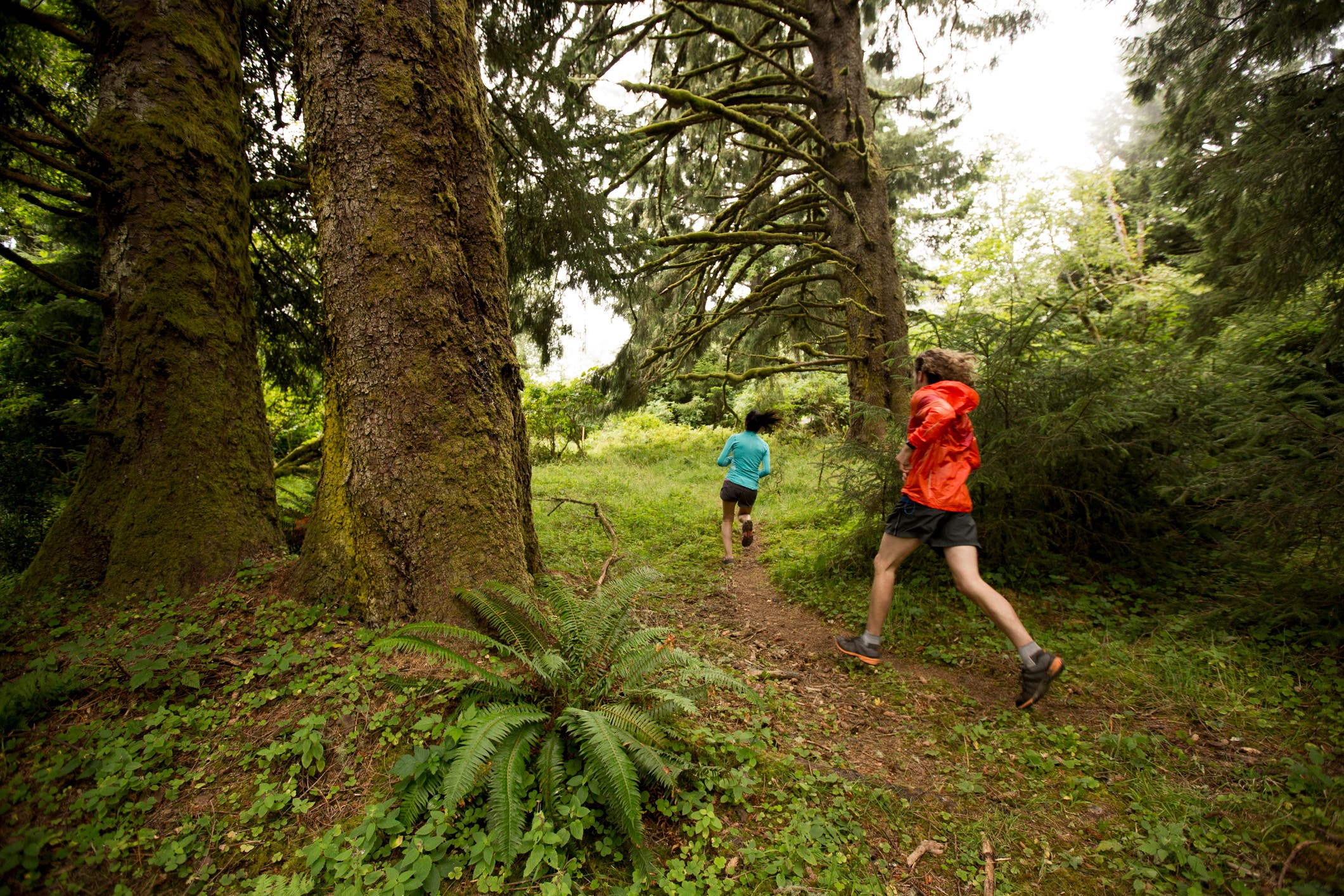The Exciting, Rapid Adaptations From Speed Work In Studies

A woman trail running in Bryce Canyon.
The training theory used by some Norwegian athletes has gone full Hansel. It is so hot right now. Most analyses (including mine) focus on the monstrous double threshold sessions, with AM and PM workouts at sustainably fast speeds. But I think there’s a less sexy element that is far more important for most athletes: consistent near-maximal speed and power development.
In an article published by Dr. Marius Bakken on the “Norwegian model,” there was a sample week that included two double-workout days, plus these two sessions:
- 20 x 220 meter hill repeats with 70 seconds jog recovery
- An evening double with “speed” noted, likely via fast strides, though it’s not specified
For world-class athletes, the hills are likely around 35-40 seconds, depending on the gradient. While this is not a universal example for everyone training under these systems, it is instructive. These athletes are not just doing the grind-it-out threshold intervals that get the headlines. They’re also doing a large quantity of hills and strides.
I worry that athletes may read about these training approaches and miss the speed- and power- development that may make those sexy threshold workouts lead to success. Let’s dig into two exercise physiology studies that show stunning results (my co-coach Megan and I talk more about these studies and principles on our podcast here).
RELATED: Try Our Six Week Training Plan For Speed
The Science of Speed Work
The first article was published in 2018 in the Journal of Strength and Conditioning Research, examining how just 2 weeks of speed training can influence performance in trained trail runners. The study included 12 men and 4 women who had been training at least 50km per week for the previous 3 years. Participants did 3 speed sessions per week (6 total), consisting of 4 to 7 x 30 second fast shuttle runs with 4 minutes recovery between each. Shuttles involved running 5 meters out, 5 meters back, 10 meters out, 10 meters back, and so on for the 30 seconds. The baseline and post-intervention tests were a maximum aerobic speed test starting at 8 km/hr and increasing by 1 km/hr every 2 minutes, a time to exhaustion test at 90% of maximum aerobic speed, and a 3 km time trial.
Reading this study for the first time, I was skeptical. Shuttle runs? For 2 weeks? In trained runners? If an intervention that is so simple, so short, and so non-specific actually works, then complex coaching approaches seem to be built on a throne of lies. Ever since elementary school, I always worried that my life’s purpose would be undercut by shuttle runs or the sit-and-reach.
Maximum aerobic speed improved by 2.8%, time to exhaustion at 90% of maximum aerobic speed improved by 159 seconds, and 3k time trial time improved by 5.7%. IN TWO WEEKS! With just 6 sessions of shuttle runs! Maybe I should have been a plumber.
Those findings are not anomalous, with many previous studies having similar results. A 2014 review article in Sports Medicine found 16 different trials involving 318 participants doing 30-second intervals, with an aggregate aerobic capacity improvement of 8%. The authors of the 2018 study theorize that “the rapid improvement seen was largely due to an increase in the enzymatic activity of the aerobic system.” They also throw in a grab-bag of other potential explanations based on other studies, including increased markers of aerobic metabolism, improvements in the lactate shuttle, and enhanced neuromuscular capacity. Whatever the cause, it adds up to improved running economy in a short time, with high outputs taking less energy. That should distribute to better running at all distances with specific training.
RELATED: 5 Workouts To Get You Faster In 20 Minutes Or Less

Study Two
That study is cool, but let’s kick it up a notch by looking at a more detailed examination of the mechanistic factors. Now, we’re getting to what might be my favorite study of all time. You heard me right. If we were playing FMK, I’d F this study, M this study, and K any study that is not this study.
Published in 2018 in Physiological Reports, it had 20 trained athletes (14 men and 6 women) complete a 40-day intervention with 10 speed sessions involving 5 to 10 x 30 seconds maximal running with 3.5 minutes of recovery between each, in conjunction with a 36% reduction in total weekly volume. Before and after the intervention, participants did a time-to-exhaustion test, two 10km tests (one with glycogen depletion) preceded by 2 x 6 minute intervals at 60% of VO2 max, and a series of muscle biopsy and blood tests to measure changes on the cellular and systems levels.
The results were staggering. Running economy during the 10k improved by 2.1% and during the intervals at 60% of VO2 max by 1.7%. In other words, the athletes improved at both hard efforts and easy ones. In the depletion test, “the running economy remained unchanged with training.”
That’s a big effect size in trained runners, particularly given the volume reduction. What the heck is happening? Here is where the study goes from good to THE BEST EVER.
RELATED: 5 Simple Workouts To Build Speed For Trails
Mechanisms of Improvement
The glycogen-depletion 10k was designed to isolate some of the influence of slow-twitch muscle fiber changes versus fast-twitch fibers. With depletion, the fast-twitch fibers should be forced to carry more of the load (like at the end of a marathon or ultra). Thus, given the lack of change in the depletion tests with training, the authors theorized that improvements were primarily related to changes in slow-twitch muscle fibers. That should be a really good thing for all endurance runners, since those fibers power long-distance performance.
So what happened in those slow-twitch fibers? Expression of protein dystrophin increased, which may enhance the ST-fiber structural integrity via the actin-myosin cross-bridge, improving running economy. In addition, the expression of UCP3 decreased (it sounds like a Star Wars droid, but I’m told it’s another muscle protein), which may improve mitochondrial efficiency.
And the fast-twitch fibers may have played a role in reducing energy consumption as well. Expression of the muscle protein SERCA1 decreased by 22% in fast-twitch fibers, which could reduce the energy turnover during exercise because that protein is connected to a process that may use up to 50% of energy. Enzymatic activity and testosterone:cortisol ratio also went up.
Don’t be discouraged, I only kinda know what a few of those words mean. The point is that as researchers introduce short stride-like speed sessions and measure more variables, they often see major changes that may explain the performance differences. So when we use the term “running economy,” we’re actually incorporating dozens of these physiological variables, some of which we can measure and some of which we can’t, from the cells to the muscles to the circulatory and cardiovascular systems. Getting faster is a scarily complex algorithm, and that is so freaking exciting! I take it back, coaching is a valid profession. Take that, shuttle runs!
RELATED: How and Why To Run Strides to Build Speed For Trails

There are a million open questions.
These adaptations happen fast, but do they continue long-term? And if they do alter their trajectories, is it possible that they can be counter-productive in longer races, or for very advanced athletes? How much do they need to be reinforced (if at all)? Will those adaptations change when incorporated with a well-rounded training program? The studies often use 30 second intervals, but how about 20 second strides, or 1-minute sustained efforts? Could athletes get the same benefits from longer intervals with no high-speed sessions at all?
My big takeaway is that it’s important to get fast and stay fast, as close to year-round as possible. While I love the studies, that assertion starts with the training theory. Whether it’s the Norwegians doing their short hills, the Kenyans doing diagonals and other sprints, Lydiard-like systems doing fast hills, or the fast strides common in most US-based systems, it’s a nearly universal element for a reason. Megan and I love 20-30 second hill strides to start, with flat strides periodically for durable athletes, usually done 1-3 times per week throughout most of the year.
These studies may uncover some of the mechanisms that support the training theory. But as much as I love some good muscle protein expression, I think that it’s best to keep the training framework for short, fast intervals as simple as possible. By raising the ceiling of sustainably fast output, most athletes will also raise each percentage of that ceiling, from mile races (90 to 95% of max) to ultras (much smaller percentages of max).
Mechanical output, neuromuscular/biomechanical efficiency, cardiac output, and aerobic development all interact in really complex ways that can be tough to fully predict. What should you do in the face of that complex algorithm governing performance changes over time?
I’m not sure there’s a universal answer. But I think the studies point to a simple principle that will work for most athletes:
Get fast, and stay fast, on top of consistent aerobic training, and a lot of the complex variables fall into the right places.
RELATED: Try These Workouts To Get Faster On Trail
David Roche partners with runners of all abilities through his coaching service, Some Work, All Play. With Megan Roche, M.D., he hosts the Some Work, All Play podcast on running (and other things), and they wrote a book called The Happy Runner.